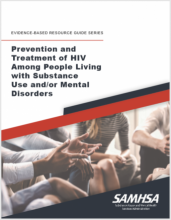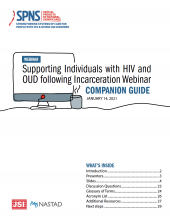
This resource describes how state health departments and other public health organizations can partner with people with HIV and/or who use(d) drugs in programmatic and policy making processes and evaluation.



This resource describes how state health departments and other public health organizations can partner with people with HIV and/or who use(d) drugs in programmatic and policy making processes and evaluation.
Individuals who have HIV who also use drugs experience increased age-matched morbidity and mortality in comparison with those with HIV who do not use drugs.
This document provides a quick overview of the federal discretionary funding programs that support essential aspects of the nation’s HIV response.
Achieving the goals of the Ending the HIV Epidemic (EHE) Initiative depends on doing more to strengthen communities, reduce the harm associated with drug use, and prevent disease transmission.
This publication, part of SAMHSA's Evidence Based Resource Guide series, addresses the co-occurrence of HIV and mental illness and/or SUD.
This article describes how the HIV testing window period is a challenge related to prescribing PrEP for people who inject drugs, and discusses current approaches and how data are needed to help guide best practices.
This virtual session summary describes key takeaways from the August 2020 Let's Talk about SSPs as Essential Services conversation.
Developed as part of the Strengthening Systems of Care for People with HIV and Opioid Use Disorder project, this document contains brief descriptions of federal policy and systems changes due to coronavirus 2019 (COVID-19) that relate to the HIV and substance use systems of care, along w
To address the infectious disease consequences of the opioid crisis in the U.S., a public workshop titled Integrating Infectious Disease Considerations with Response to the Opioid Epidemic was convened on March 12 and 13, 2018, by the National Academies of Sciences, Engineering, and Medicine.